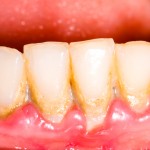
Periodontitis is a common problem globally having an important impact on oral health related quality of life as well as a significant economic burden. Periodontal disease results from the interaction between the dental plaque biofilm and the individuals immune-inflammatory response and is associated with smoking, diet and alcohol consumption.
The main aim of this review was to review the evidence for the relationship between non-surgical periodontal therapy and patient-based outcomes.
Methods
Searches were conducted in the Medline/PubMed, Embase, Cochrane Google Scholar, LILACS, CINAHL and Web of Science databases and restricted to the English language. Randomised and non-randomised control trials (RCTs, NRCTs), prospective clinical trials and case series on patients undergoing non-surgical periodontal treatment and using Oral Health Impact Profile (OHIP-14) as a primary outcome of oral health related quality of life (OHRQoL) were considered. Two reviewers independently selected studies assessed quality and extracted data. The Mixed Model Appraisal Tool (MMAT) was used to assess quality. The case definition for periodontitis was based on periodontal pocket depth (PPD) and clinical attachment loss (CAL). A narrative summary of the findings was presented.
Results
- 13 studies (3 RCTs, 9 case series, 1 quasi-experimental study) were included.
- The studies were carried out in Brazil, Germany, Hong Kong, India, Malaysia, Nepal, Romania, Sweden, Taiwan, Turkey and the UK.
- Follow-up periods ranged from 1 week to 12 months.
- Eleven out of the 13 studies reported significant improvement in OHIP- 14 scores
Conclusions
The authors concluded: –
Non-surgical periodontal therapy improved OHRQoL outcomes, particularly by reducing pain, psychological discomfort and physical disability. The strength of evidence provided by this paper should be interpreted cautiously because the included studies ranged from case reports to randomized controlled trials, with short-term (1 week) and long-term follow-ups (12 months). The implications of OHRQoL recording are useful in determining the quality of care, evaluation of clinical practice, improving patient safety and developing knowledge on patients-based outcomes research
Comments
A broad range of databases was searched for this review although restricting inclusion to the English language may have excluded some studies. Earlier this year we looked at a similar review by Botelho et al (Dental Elf – 18th Mar 2020) That review included 12 studies in comparison with the 13 included in the current review. While both reviews looked at the impact of periodontal disease on oral health related quality of life this new review only included studies that used OHIP-14. It is interesting to note that although the earlier review included 7 cohort studies that used OHIP-14 there were only 5 studies common to both reviews. While the findings of both this review and the earlier Botelho one suggest that periodontal treatment improved quality of life, the quality of the supporting evidence is limited.
Links
Primary Paper
Khan S, Khalid T, Bettiol S, Crocombe LA. Non-surgical periodontal therapy effectively improves patient-reported outcomes: A systematic review [published online ahead of print, 2020 Jun 28]. Int J Dent Hyg. 2020;10.1111/idh.12450. doi:10.1111/idh.12450
Other references
Dental Elf – 18th Mar 2020
